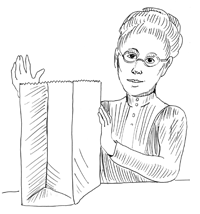STRANGE BUT TRUE- Margaret Knight: She built a better food trap...

DRAWING BY DEBORAH DERR McCLINTOCK
Q. "I was famous for the kites I made, and my sleds were the envy ... of all the boys in town." What invention is this woman world famous for today, more than a century after a court battle for the patent and after she was awarded the Decoration of the Royal Legion of Honour from Queen Victoria? You probably don't know her name but have doubtless used countless of this product when shopping. –T. Joe
A. She was Margaret Knight (1838-1914), one of the first American women to be awarded a patent, says Jack Challoner in 1001 Inventions That Changed the World. She was a prolific inventor from the age of 12, when an accident in a textile mill prompted her to design a safety feature to protect workers from the loom.
However, of her 20+ patents, the flat-bottomed paper bag is her most widely remembered invention. Knight was working in a paper-bag factory after the American Civil War when she saw the need for a boxier shape to replace the envelope-slim bags unsuitable for bulky items. Since the flat-bottomed bag could be made only by hand, Knight designed a wooden prototype of a bag-maker that she sent to a machine shop, where an unscrupulous employee stole her design and got the patent.
But the decision was overturned in court, with Knight bagging what, from the beginning, was rightfully hers.
Q. What's the surprising condition (four-letter word) that those naughty four-letter words might help you get rid of? –O. Sacks
A. Although the news probably won't stop parents from washing kids' mouths out with soap, cussing a blue streak may actually help alleviate p-a-i-n, says Laura Sanders in Science News.
"Swear words are unique," explains psychologist Timothy Jay. "They're really the link between the language system and the emotional system."
Inspired by the unsavory language his wife let loose during the throes of labor, psychologist Richard Stephens of Keele University in England experimented with undergraduate students to see if uttering emotion-laden choice words would alter their pain perception. When the students dipped a hand into uncomfortably chilly water, the swearers were able to stand it for longer than controls uttering innocuous words, and afterward recorded feeling less pain. Swearing also increased heart rate, a possible signal of the fight- or-flight response that can increase tolerance for pain.
This goes beyond whether swearing should be frowned upon by polite society, Jay stresses. "When you try to describe swearing in moral terms– is it good or bad— it keeps you from getting at the deeper evolutionary links."
Q. Worldwide, the IUD (intrauterine device) is the most widely used reversible contraceptive, says the Population Council. When was it first introduced? –M. Sanger
A. Its pedigree dates back to the days of Bedouin tribesmen, who inserted peach pits in the uteruses of female camels to prevent pregnancies during cross-desert treks, says David Bodanis in The Body Book.
The more delicate human version was introduced in the 1930s, as a coin-sized silver spring. Since then, varying types have been produced, many copper or hormone-activated, molded in plastic, their shape "limited only by the designer's imagination, whence the Birnberg bow, Margulies spiral, Lippes loop. One twisted in the owner's monogram would possibly work as well, providing perhaps the ultimate in discreet vanity symbols."
Still, how an IUD works is unclear, says the Contraceptive Information Center of the Journal of the American Medical Association. Maybe it immobilizes sperm, or speeds the egg through the fallopian tube too fast for fertilization to occur, or thwarts embryo implantation.
Whatever, the peach pit worked on the camels, today IUDs work for an estimated 60 million Chinese women alone, according to the Population Council.
~
Send Strange questions to brothers Bill and Rich at [email protected].
#